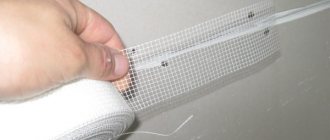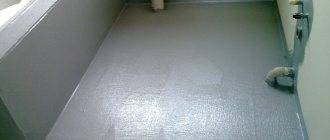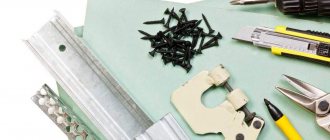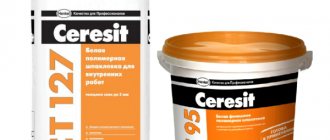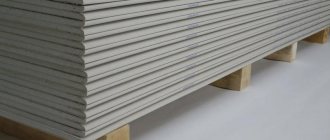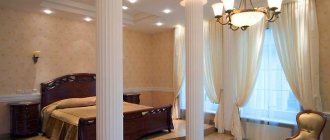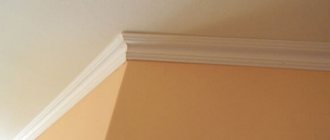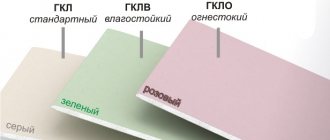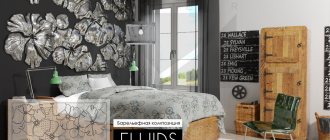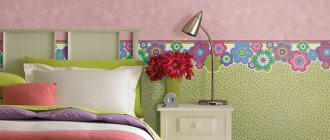It is impossible to work with drywall without a special tool - it is too specific a building material. GKL sheets are inconvenient to carry. You can’t cut them or bend them just like that, without devices and tools. The sheet itself is quite heavy, and you also need to mount it on the wall, and even more so on the ceiling, using special tools. Therefore, those craftsmen who plan to use plasterboard in the construction or renovation of housing should know about the existing tools for drywall in order to make it easier to work with this popular material.
Best Plastic Sanding Planes for Drywall
This type of tool contains knives in the form of a perforated plate, like a kitchen grater, which allows you to rip off the end of the gypsum sheet to a flat plane (initially it comes with a bevel). This promotes smooth joining and beautiful jointing.
TOPEX 250 mm 11A411 - for two-handed operation
This is the best plane for drywall when large volumes of peeling are required and a separate person is involved in this, and other craftsmen can already take the finished sheets and install them. It is advisable to install the sheet on the edge and fix it in order to fully and quickly peel. The tool is designed to be held with two hands, which provides optimal pressure on the roughing surface and a better result. To do this, there is a D-shaped handle at the rear and a high stop at the front.
- additional intermediate posts in the planer design increasing its strength;
- the high emphasis on the front allows full pressing with the second hand;
- Suitable for wood, plastic and plaster;
- sole length 250 mm ensures high performance;
- the ergonomic shape of the handles fits well in the hands;
- knives made of tool steel;
- weight 160 g is easy to work with and carry the tool on your belt.
- cost from 470 rubles;
- no belt clip;
- The faceted handle presses the palm with a strong grip.
MATRIX 879065 - for one hand
This type of planer for drywall is the best due to its compact size, which is important for a master working alone. With its help, you can hold the sheet with one hand and quickly align the end for joining with the other. The length of the plane is 140 mm, so it is convenient to carry it on your belt and manipulate it even on short workpieces.
- cost from 200 rubles;
- durable body;
- there is a small stop for additional pressure with the second hand;
- capable of processing even fiberglass and gas silicate blocks;
- weight 140 g;
- 42 mm cutting surface width facilitates fast processing;
- compact dimensions 160x120x50 mm are optimal for storage and transportation;
- quick replacement of the working blade;
- removal of chips through special holes;
- with the proper experience of the craftsman, it is even suitable for chamfering and finishing edges.
- for a person with large hands it may be small (be careful when ordering online, you just need to pick it up and look);
- on sheets with soft plaster (etc.) it lifts the paper when cut.
Planers for drywall
Roughing planes
Depending on the design and purpose, there are two types of plasterboard planes - edge and roughing.
Roughing plane
A plasterboard planer is a special tool designed to smooth out the edges of plasterboard. Sometimes a roughing plane is called a rasp for drywall, and its popular name is “gypsum board grater.”
The design of the roughing plane is as follows:
- The main part of the plane is the peeling blade. It has the shape of a grater (hence the popular name) and is made from hardened steel. The cutting edges of the stripping plane blade are configured to produce the most even end of the plasterboard board.
- The body of the plane is designed to secure the blade and guide it when working with the plane. Most models of planes have bodies made of silumin or reinforced plastic, but there are also models with an all-steel body. Unfortunately, the price of such a professional plane is quite high.
- The handles of the plane are made of plastic or are a continuation of the body.
Advice! If you purchased an inexpensive plane with plastic handles and plan to work with it for a long time and intensively, experts recommend replacing the handles with wooden ones. They will last longer, and your hands won’t get so tired.
For small areas, instead of a full-fledged roughing plane, you can use a hand rasp, somewhat reminiscent of a cheese grater.
Hand rasp for finishing edges
Edge planes
Unlike a roughing plane, an edge plane for drywall is used not for leveling the edge, but for cutting it as evenly as possible at a certain angle (most often at 45 0).
- The main part of an edge plane for working on drywall is a trapezoidal blade made of high-quality steel. In high-quality models of planes, the angle of the blade can be adjusted using special screws. If the blade fails or loses its sharpness, it can be easily replaced.
- The body of the edge plane is made of steel. To protect the housing from corrosion, powder coating of the metal is used.
- Like a roughing plane, the handles can be made of wood or plastic. As a rule, the more expensive the plane, the more convenient and durable the design of its handles.
Edge plane
Edge planes can be used not only for drywall, but also for plastic, and also for processing softwood panels.
Plane selection
The low cost of most models of gypsum board planes allows you to choose the tool that is most suitable for you.
In this case, you need to focus on the following parameters:
- The working part of the plane should be in the range from 150 to 250 mm. The smaller the plane, the easier it is to handle, but with a longer plane you will quickly process the end of the sheet of the required length.
- Planer blades must be made of high quality tool steel. You should not skimp on this component, since cheap planes with low-quality blades do not provide high-quality edge processing, and they also quickly fail.
The optimal width of the roughing plane blade is 30 mm. There are models of planes on the market with blades from 12 to 45 mm, allowing you to process slabs of different thicknesses.
When it comes to plane handles, the best way to choose is to take the plane in your hands and try to run it along the edge of the drywall. No instruction will help better than your own feelings.
The best edge planes
To evenly cut a sheet of drywall, edge planes are used, which are distinguished by thin protruding knives. Some models are capable of cutting at different angles, if this is required for a tighter joint.
FIT 15025 - the most common model
This is the most famous edge plane that every second drywaller has. It is the best due to the presence of two knives and the ability to cut at angles of 22.5 and 45 degrees. There is also a classic 90 degree cut. For holding, a protrusion is provided that corresponds to the shape of the back of the hand when grasping it.
- there is an adjustment of the cutting depth depending on the thickness of the plasterboard sheet (9.5 / 12.5 / 15 mm);
- variable position of the knives by turning the pressure wheel;
- blades made of tool steel;
- light weight 280 g;
- streamlined body shape is comfortable to wear and grip;
- long service life with the ability to replace broken knives.
- cost from 390 rubles;
- may periodically tear out the paper with the first knife (users have come up with the idea of swapping the pressure plate of the first knife and the blade, which eliminates this problem);
- plastic fasteners.
Stanley STHT1-05937 - the choice of a true professional
Real craftsmen who have to process 20 or more sheets of drywall per day prefer to use the best plane from Stanley, which is highly accurate and reliable. The tool has a comfortable handle made of thick rubber with cutouts for the palm, which makes it easier to hold firmly.
- compact dimensions of 200x60 mm are convenient for one-handed operation and storage on the belt during sheet installation;
- adjustable blade height allows you to work with different sheet thicknesses (from 6.5 to 13.5 mm);
- the body has a metal corner that serves as a guide, which prevents the tool from moving to the side while making a cut;
- the knife can be easily replaced with a new one by unscrewing the pressure wheel;
- good visibility for the cutting area master;
- trapezoidal knives are stronger than regular knives and are available for purchase at any hardware store;
- high-quality assembly with a cast base helps reduce vibration during operation.
- cost about 900 rubles;
- There is no loop for hanging on a belt.
What knives can handle cutting drywall?
Special devices and tools for working with the material can speed up and facilitate the cutting process.
Drywall sheets consist of two layers of cardboard with a gypsum-based filler. The complexity of the cutting process lies in the fact that the cut edges of the sheets must have a smooth surface. This quality can only be achieved with the help of a special tool. You can find several types of knives on sale that do this job well.
Special
On sale you can find two types of knives for cutting drywall. They have the same basic structure, but differ in some details. Externally, special knives resemble stationery knives.
The blades in special knives for cutting drywall are made removable. They are made from a material that has increased strength.
The standard characteristics of this type of knives are::
- blade thickness – 0.4-0.7 mm;
- blade width – 18-24 mm.
Expert opinion
Mezentsev Sergey Petrovich
Residential renovation and finishing specialist
High-quality special knives have a metal body that ensures reliable and precise fixation of the blade.
The handle of such products must have a rubberized coating. It prevents your palm from sliding over the tool while working.
Universal
The tools are popular among builders. They are often called assembly knives. Use utility knives for various types of work, including cutting drywall. They have a comfortable handle made of lightweight metal or plastic alloy. Their surface is covered with a lining made of multi-component rubber.
The blades of universal knives are made of high-carbon steel and have a removable version. They have a trapezoidal shape. To attach knives to the belt, the body of the product is equipped with special clips.
Attention! The blades of utility knives are adjustable according to the length of the blade.
The choice of blade length depends on the thickness of the plasterboard sheet. The disadvantage of universal knives is that the knives quickly become dull. The cost of a tool with a trapezoidal blade shape is significantly higher than special knives.
Blade runner
A new generation of cutters, characterized by high productivity, cut quality and ease of use. The design consists of two equivalent cutting devices. When cutting drywall sheets, they are held in place by strong magnetic clips.
Before starting work, markings are made on sheets of material, and then the cutter is run along it. During this process, the marking line of the sheet should coincide with the line on the body of the bladerunner. A tool of this type can be used for cutting plasterboard elements of any configuration.
Attention! Bladerunners allow you to cut vertically positioned sheets of material.
The tool copes well with fire-resistant and moisture-resistant types of drywall. It is capable of cutting their sheets having a thickness of 12.5–15 mm.
With disc blade
This type of tool is used for high-precision cutting of drywall sheets. The second name for knives is thicknesser cutters. It can be used to cut straight and curved lines. The rotating blade of the knives can withstand heavy loads.
High-strength steel is used for its manufacture. A big advantage of the tool is the uniform depth of penetration of the circular knife into the thickness of the drywall.
Best Metal Sanding Planes for Drywall
Due to the greater mass and metal sole, such a tool allows you to quickly obtain an even end for joining. These planes are distinguished by their increased strength, which is especially important for everyday use.
SANTOOL 250 mm - the most convenient
This is the best metal drywall planer for ease of holding. Its main handle has two bends that completely correspond to the shape of the user’s clenched hand.
There is a stop at the top of the handle to prevent the tool from slipping out during intensive work. The second handle is made in the form of a stop and is covered with dimples, which increases the reliability of the grip. Tilt of the stop forward makes it easier to set the stroke.
- Full metal body, protected from cracks when dropped;
- the oblong base is fastened with an additional jumper to increase rigidity;
- the sole length of 250 mm allows you to remove a large layer at a time, which increases productivity;
- for the exit and accumulation of chips, there are compartments at the top that collect them so as not to fill the cutting line and not block the view of the master;
- the knife can be replaced by unscrewing the screw on the front of the housing;
- weight 300 g does not make work difficult;
- small dimensions 250x110x90 mm;
- does not deform during everyday use.
- cost from 660 rubles;
- there is no fastener for hanging on the master’s belt;
- the handle is plastic and slips a little in sweaty hands;
Due to the increased length of the tool and holding it with two hands, additional fastening of the drywall sheet is required during stripping.
What should you consider when choosing?
The choice of tool depends on the type and volume of work. Cutting sheets of drywall in a straight line can be made with a regular construction or stationery knife with a thick and hard blade.
Using a regular stationery knife does not allow you to achieve a perfect, even cut. Aligning the edges will have to be done using other tools.
For safe operation, the tool must be comfortable to hold. The knife handle should have rubberized lining. The instrument itself should not be heavy and bulky.
It is better to choose steel blades with increased strength and rigidity. The thinner it is, the smoother the cut of the material will be. For one-time work, an inexpensive product option is suitable.
Knives with a trapezoidal blade are considered optimal for cutting drywall. It is highly rigid and allows you to make precise straight and broken cuts.
Roughing and edging plane for drywall: how to make it yourself
Drywall is one of the most popular and frequently used building materials for interior decoration. With its help, you can perform a huge number of repair and construction tasks, getting excellent results at a relatively low price. But despite the fact that gypsum board is very easy to use, its installation and processing also requires certain skills and a set of tools. For example, to create smooth seams and joints without gaps, you will need an edge or roughing plane for drywall. Let's figure out how to use this tool, what its features are and how to make a planer for gypsum boards with your own hands.
Purpose of a planer for gypsum boards
This tool is indispensable when processing plasterboard sheets. Since gypsum board consists not only of thick cardboard, but also of very fragile gypsum material, the edges of these sheets often crumble or chip. It is in this case that they have to be processed with a special plane for drywall.
In addition, in order to properly seal the joints with putty when facing gypsum plasterboard walls and ceilings, the edges at the junction of the sheets must be chamfered at an angle of 45 degrees. This creates a recess that is filled with a special putty compound, and in the future there will be no bulges or cracks on the seams.
In principle, sandpaper can be used to process the edges of a sheet, but its use will not give such a perfectly smooth and clear edge as when using a plane.
Kromochny
An edge plane is used for chamfering, processing the edges of gypsum boards, and also for performing more even cutting of gypsum boards at the desired angle (most often 45 degrees). The blades of such a tool have a trapezoidal shape and can be shifted, which allows you to process the edge to a depth of 2 to 8 mm.
- Plastic or metal body with handle.
- Tension screw for fixing the blades.
- Planing blades installed not in the sole of the plane, as in the familiar carpentry tool, but on the side.
A standard edge plane is designed to bevel at an angle of 45 degrees. If necessary, you can find a tool for shaped chamfering when creating curved structures.
A quality edge plane can be used when working with softwood and plastic.
Drywall screwdriver
screwdriver for drywall
When choosing a screwdriver for drywall, you should give preference to models with the ability to continuously adjust the power of tightening the screws. The operating range of rotation of the head when working with this material is 200-400 rpm.
It is not recommended to use an overly powerful tool, as in this case you risk damaging the drywall sheets and metal profile. This will save you from the risk of damaging the plasterboard during installation work.
On sale you can find screwdrivers with automatic feeding of screws. Using such a tool will significantly speed up repair work.
When covering walls and ceilings with gypsum plasterboard, the screwdriver is subject to increased load, which leads to rapid discharge of the tool’s batteries. Therefore, we can recommend that you use electric models, which will save you from such difficulties. Pay attention to the cable length, which should be 4-5 meters. But working with a screwdriver whose cable length is 2-3 meters is not very convenient.
Rough
A roughing plane is used not only for processing the edge of a sheet, but also for leveling it. It is with its help that the edge is perfectly smooth, which allows you to adjust the plasterboard sheets to each other with even joints to simplify the finishing of the surface.
Unlike an edge plane, the working surface of the roughing tool is located on the sole and is not a blade, but a kind of grater with many holes with sharp edges.
Working with the tool involves the master running it over the surface to be treated, carefully removing excess gypsum filler and cardboard edges from it.
A roughing plane is indispensable when you need to get a perfectly straight straight edge (90 degrees), and an edge plane when you need to create an oblique edge.
Homemade roughing plane
You can make such a tool yourself. Video instructions for making a roughing plane yourself.
To make such a tool you will need:
- NP (profile - guide). These profiles differ in the composition of the metal, which gives strength;
- wooden board, maybe timber;
- scissors for cutting metal;
- screwdriver;
- small wood screws.
The planer should be done step by step - in stages:
- A profile of double the length of the tool is required (let's say the length of the plane surface is 15 cm, a profile of 30 cm is required).
- On the side, the profile is cut with scissors in several places to fold it inward (it must be folded later).
- Half of the profile must be attached to the wood and holes must be made in the metal base with a screwdriver. The base will be good if it has a lot of holes.
- After this you need to fold the profile. Screw in self-tapping screws on the sides to secure the box.
- If there are sharp corners, they should be knocked down a little with a hammer.
- For ease of working with a homemade tool, it is wrapped with electrical tape.
This plane is only suitable for home repairs. But, with its help, you can do all the necessary operations with drywall to get an ideal structure.
Criteria for choosing a plane for plasterboard slabs
In order to make the right choice of a plane that is suitable for processing exactly your type of plasterboard sheets, you should pay attention to the following parameters of this construction tool:
- Length of the working surface (for grinding tools). Typically it ranges from 14 to 25 centimeters. The larger this parameter, the more surface you can process in a shorter time.
- Working blade width. It is 15–42 millimeters. The value of this indicator should be chosen depending on the thickness of your gypsum boards. Some tools allow you to adjust the width, which makes it easy to use them to process a wide variety of types of gypsum boards.
- Work surface material. The blade itself is made of both regular and tool steel. It is preferable to choose the second option, since such steel is stronger and more durable in use.
You also need to choose a tool that will fit comfortably in your hand. There are many models here, from which it is easy to choose the one that suits you.
An important criterion when purchasing a planer for gypsum boards is its cost. Using this parameter, you can also find models in almost any price category. For example, the price of an ordinary small Russian-made instrument starts at 250 rubles, and for professional models from well-known companies such as Knauf, the price will be 3,500 rubles or more.
How to make your own drywall planer
A do-it-yourself plasterboard planer can be made from available tools and materials that you will probably find in your apartment when decorating a room with plasterboard sheets. For this you will need:
- Metal guide profile (it is best to choose the Knauf brand, since cheaper analogs are not suitable for the strength and quality of the metal).
- A small piece of wooden board or block.
- Metal scissors.
- Screwdriver.
- Self-tapping screws.
The process of making a plane for processing drywall step by step:
- The length of the profile is measured so that it is approximately twice the desired length of the working surface of the tool being manufactured.
- We cut the side edges of the profile in such a way that when folded in half it looks like a box. But we haven’t put it all together yet.
- We apply one of the profile halves with the front side (this is the part that will be working) to the wooden surface and use a screwdriver to make through holes in it. The more there are, the better - it should look like a grater.
- Now we fold the profile in half and secure its side edges with self-tapping screws on both sides.
- Using a hammer, lightly knock out the too sharp protruding pieces of the profile around the holes.
- For ease of use, so that the tool does not slip out of your hand, its side edges and top part can be wrapped with electrical tape or covered with any non-slip material.
Edge plane for drywall. Making perfect joints
Due to its versatility, ease of processing, relatively low cost and excellent characteristics, plasterboard is becoming increasingly popular in finishing work. In any room, residential or work, today this material is used to level walls, create niches, erect partitions or multi-level ceilings. It is clear that special tools have appeared for working with it, one of which is an edge plane for drywall.
Drywall bits
bits for plasterboard
When covering walls and ceilings with plasterboard sheets, certain problems arise when fixing the sheets with self-tapping screws. When using a screwdriver, there is a danger of overtightening the screws, which in turn damages the cardboard layer of the drywall.
As a result, such cladding must be replaced and the finishing done again. All this invariably leads to increased costs for repair work. A screwdriver bit will improve the quality of the work performed and eliminate the danger of overtightening the screws.
Currently on sale you can find various bits for drywall, which are a special head for tightening screws. A high-quality bit has limiters that protect the drywall sheets from damage. Remember that to work with drywall you will need a bit with a Phillips bit. Using this tool is not difficult, which will allow you to improve the quality of your finishing work.
Arrangement of edge planes
The design of the plane is quite simple and, as a rule, is familiar to everyone who has encountered wood planes, since there is no fundamental difference in the design. The difference is that the edge plane for drywall is not intended for leveling the surface, but for creating a chamfer on the edge of the drywall sheet at a certain angle (in most cases, the angle is 45°). The design of the tool is modified accordingly to perform this task.
The body of the plane is made of metal or polymer materials. Plastic tools, as practice shows, perform quite well, but most professionals still prefer metal planes. The cutting tip itself (most often trapezoidal) is attached to the body using a special screw. This allows you not only to change the knife if necessary, but also to set a certain processing angle or change the position to work with sheets of different thicknesses. It is clear that not all instrument models can be adjusted. In addition, you can find planes with two knives.
If the blade is securely fastened, it is possible to remove edges from wooden or plastic parts. However, it should be remembered that inappropriate use of the plane does not benefit it. To hold the tool in your hands, one or two handles are placed on the body. When choosing an edge plane, the handles are often given special attention, since the comfort of the grip affects not only the feel of the worker, but also the quality of the resulting edge. It is advisable to hold the tool with your own hands to evaluate how convenient it will be to use.
Types of planes and their purpose
Carpentry as wood processing is a whole profession, deep and original. It includes a range of tool types, similar and different. Over the centuries, the shape and design of the equipment have been developed.
The purpose of the tool is as follows (names and subtypes are not given, there are a lot of them):
- primary processing and removal of rough outer layers;
- planing in depth to remove the layer;
- precise surface treatment and leveling;
- removing a sharp edge and removing a quarter - to give it roundness;
- correction of processing defects;
- final cleanup.
Specializations may include removing bark, processing large areas, or finely clearing knots, or developing irregular tree structure. It is possible to give special shapes - for windows and doors, cornices or baguettes. Grooves and various recesses are made.
There are types of planes for other materials. Modern materials are processed by modern models:
For drywall
Drywall lends itself well to cutting, but the quality of the edges leaves much to be desired. A special plane is used to level and sand the edges.
Planer for drywall
Processing is carried out for different edges: for putty, connection without cutting or with a chamfer, for gluing with reinforcing tape. For this purpose, two types of hand planes are available: edging and roughing.
The first one cuts off the excess with 2 knives. The output is a chamfer with specified angles.
The second sands the edges to join the sheets. Looks similar to a kitchen grater - but made of hardenable steel and with a pair of handles.
GKL (gypsum plasterboard sheet) is processed quite easily due to its low local cutting strength.
For aerated concrete
In construction, a plane is widely used for aerated concrete, gas silicate blocks and foam blocks. Professional models are produced, but you can make one yourself.
Planer for aerated concrete
Other names: grater or scraper.
The blocks produced have deviations in geometry, and the hardness of the material is not very high. Even adhesive-mounted gas silicate blocks need to be leveled as much as possible to simplify laying out the walls. Refinement for alignment is very convenient and is done locally. Removal of the layer is carried out using abrasive blades or metal brushes.
A special feature of the tool is that it has several rows of cutting edges.
Edge plane
There are different types of edge plane for drywall. There are types for building blocks (soft, such as foam concrete or aerated concrete) and wood. Planing is carried out to different depths, and the edge becomes extremely smooth.
Edge plane
Sometimes even millimeters play a role in the installation of an entire element, which makes it necessary to remove them. A knife will not work - only a plane will remove it evenly and over a considerable length. Its subtype is the chamfering mechanism.
This tool is designed like its counterparts: a wooden or plastic body, a cutting knife and a handle. The latter may not exist, but it is more convenient. There are manual and electric options.
The use of the plane is simple. The element (block, sheet, piece) is fixed with the area being processed upward. After this, the edge is finished.
Plastering plane
A plaster plane is not the most common tool, but it is very necessary on a construction site. It is needed not for any plaster, but for mechanized plaster.
Plastering plane
The surface obtained by accelerated casting is characterized by high roughness. The resulting coarse layer is very grainy and requires refinement, unless it is specially created. In addition, the application of the plaster layer is carried out in strips that have different thicknesses. It is good to remove the difference with such a tool.
There are devices for flat and corner surfaces. The greatest benefit will come from processing a solution that has not yet fully set.
Wood planer
It is the first recalled variety of its class. Used for planing wood and leveling its surface. Includes different types of hand planes: from mini plane to long-length jointer.
Wood planer
It is used not only for removing the top layer of wood, but also for removing quarters and grooves. Corner designs help in processing uneven lines and ends.
Planers can be manual or electric. The knife can be set at an angle over a wide range. The body is made of wood, plastic and metal. Angular - always with solid guide parts.
Straightening plane
The main role of this device is to remove outdated coatings from surfaces. Choosing a plane - taking into account the coating: putty, paint, scale, cleaning from contaminants in preparation for further processing.
Straightening plane
Roughing work is carried out in construction, bodywork and similar work on metal and stone surfaces. There are models for grinding and purely cleaning operations.
Functioning consists of reciprocating movement along the surface and removing waste fractions. Material – metal, handles – plastic or aluminum. There is an adjustment screw for adjustment.
Sanding plane
To finally bring the surface to the required roughness, a grinding plane is used.
Sanding plane
According to the sequence in the technological chain, it will be the last (sherhebel - jointer - grinding).
Its essence lies in the minimality of the layer being removed, or rather, in rubbing. For this, fine abrasive materials are used: mesh or sandpaper. Actuation can be from muscular force, electric current or compressed air. An electric planer is optimal for finalizing: many actions are carried out well by the engine, and the master will not be so tired.
Sanding planer
Types of planes also include scraping planes - it differs from others due to a different operating principle. Intended for work on parquet and flooring, removing the top layer and old coatings on hard wood.
Sanding planer
It does not have a chipbreaker. Its blade has a forward slope and can be adjusted. It cuts into the wood at a positive angle, the chips are wrapped, leaving the cut fibers intact.
Unlike grinding, for which there are other mechanisms, this is where the layer is removed. The remaining surface has a pleasant roughness and overall quality. Unlike a grinder (which is called an angle grinder), a scraping plane can handle hard-to-reach places. Therefore, this ancient device should not be written off.
Device – light body, blade, 2 handles.
Roughing plane
A special tool designed for trimming edges and separately protruding parts is a roughing plane. It is not necessarily bought for drywall, it is suitable for wood and gas block.
Roughing plane
The working part is a peeling cloth, which can be profiled or even semicircular. It is very similar to a kitchen appliance, hence the second name – “grater”. The body is manufactured with the greatest ergonomics, the material is any suitable. The handles are made of comfortable material, resistant to humidity and long-term use.
The main purpose is to remove a small layer, usually along the sheet plane.
Miter plane
Types of planes also include cross-cut planes. It can also be called narrow - due to its small width. It is intended for processing the corners of wood - boards in the first place.
Miter plane
The face tool is equipped with a straight or oblique knife and a chipbreaker. There can be up to 3 knives - which allows you to clean 3 surfaces at once. Purpose – final processing of ends.
For ease of operation, it is often performed with two handles. It doesn’t matter what material is used for them – metal, plastic or wood – they are taken everywhere. The knives are heat treated. The body and stock are made of not too hard material.
Operating principle and application features
Using a drywall edge plane, cut the edge of the sheet at the required angle. After joining the sheets, a small groove remains at the joint, which is sealed with serpyanka, followed by filling the seam with putty and sanding. For high-quality processing of external corners, it is imperative to use a metal corner, since the sharp corners of the gypsum board are quite fragile and the corner will crumble without additional strengthening.
To move the tool, press on the rear handle. The front one is used to guide the plane. The front handle can also be used to adjust the thickness of the material being removed. The tools are equipped with a ruler and a side stop. The corner stop allows you to cut the edge at the required angle. When chamfering, do not press the tool too hard. Gentle pressure will result in a better-quality edge, while too much pressure will result in a damaged edge of the sheet.
The blade is sharpened with a special sharpener, which is usually supplied with the plane. However, you don’t always need to sharpen the knife - you can turn it over and use it further. As the cutting part wears out, it is simply replaced with a new one, especially since many companies use knives of the same shape and there are no difficulties in purchasing them. The price of a new blade is small.
Prices and models of edge planes
Due to the fact that this tool is quite simple, the price of an edge plane for drywall is usually not too high and averages 400–750 rubles. Sometimes craftsmen make planes, especially roughing ones, with their own hands. However, is it worth spending time making a tool that is available in any hardware store and is quite cheap? As usual, everyone decides for themselves. Let's look at several models of edge planes.
FIT 15025
The tool is a simple plastic edge plane, inexpensive and practical, designed to cut drywall edges at 45° or 22.5° angles. The position of the blade is adjustable for different sheet thicknesses (for 9.5 mm, 12.5 mm or over 15 mm). The cutting tip-blade is made of tool steel and works for a long time without replacement. The price of a plane starts from 300 rubles, which makes it accessible to virtually everyone.
Stayer Profi 18855
Made of steel, the Stayer Profi 18855 plasterboard edge plane is equipped with two angled blades. The position of the cutting edges is adjustable. The tool has two comfortable plastic handles that provide comfort and reliability in holding the plane. The cost of Stayer Profi 18855 is low; like its analogues, it is designed for cutting edges and forming chamfers on the edges of drywall sheets. Use on soft wood and plastic is not excluded.
Edge plane "Kantenhobel"
The purpose, like other tools, is to trim the edges of the Knauf sheet. The angle can be set to 22.5° or 45°. Despite the fact that the price is relatively high, this is compensated by the highest quality of the Knauf company, which is practically a world standard in the production of drywall and tools for working with it. "Kantenhobel" was initially aimed at professional drywallers, but can be used by amateurs and inexperienced workers - there is nothing complicated in its use. Simplicity and reliability, safety and convenience, as well as good value for money make this tool attractive to builders.
Tools required for cutting and processing gypsum boards
There are a number of tools and devices that are used for cutting and processing plasterboard sheets.
Cutting table
This device consists of two support legs with thrust elements attached to them. There is a lattice cover on top, on one side of which a pressure ruler of the appropriate length is fixed using special clamps.
Folding workbench
An equally convenient device, the main difference of which is the removable cover, which allows, if necessary, to fold the support frame for subsequent transportation. For this purpose, special loops are designed, which are located on the end crossbars.
The material is cut using a construction knife or a cutting tool designed directly for drywall.
Sheet cutting knives
To cut the top cardboard layer of gypsum boards, special knives are used.
Narrow cutter
The device is necessary so that it is possible to cut a strip from a full-size sheet, the width of which does not exceed 120 mm. This cutting is carried out by two discs that simultaneously cut the material on both sides. Some models of such devices are equipped with an additional handle, which makes them more convenient to use.
Wide cutter
Works on the same principle, but is used to cut larger pieces of drywall. The permissible limit for sheet width in this case is 630 mm. At the same time, cutting with a regular knife gives almost the same results, which explains the rather low demand for such devices.
Hand saw
To create rectangular holes or elements with complex shapes, you will need a hacksaw with a minimum blade width and fine teeth. Such tools are made specifically for working with gypsum boards.
Roughing plane
The tool is a type of rasp with which the edges of cut sheets are processed, which allows you to align them and achieve ideal smoothness. The tool involves the use of replaceable blades, the installation of which is carried out by loosening and tightening the tension screw.
Edge plane
An edge cutter is used to trim the edges of edges to create chamfers. In this case, the angle of inclination can be 22.5 or 45 degrees. Before using the edger, the ends of the sheet must be leveled using a roughing plane.
Circular cutter
A special attachment for a drill allows you to make standard holes in drywall necessary for installing all kinds of communication elements. Such products are mainly sold in sets and have different diameters, which makes it possible to choose a cutter for a specific purpose.
Ballerina for gypsum boards
This tool also creates holes. In this case, their variable diameter is assumed, which can vary in the range of 12-320 mm. The device consists of an aluminum body and a particularly durable cutting element in the form of a roller made of carbide materials.
Needle roller
This device is used exclusively in cases where it is necessary to give the material an arched shape or create another type of curved surface. Water is applied to the plasterboard sheet, which, during the perforation process, penetrates directly into the body of the gypsum layer. The depth of the holes is 5-7 mm, and their diameter ranges from 2-3 mm. In this case, the side on which the recesses are made should be concave.
Metal scissors
The tool will be needed during the profile cutting process. This is an excellent alternative to a hacksaw, which is not always convenient to work with in certain conditions.
Power tools
These primarily include an angle grinder and a jigsaw, which can, in some cases, significantly simplify the work. Small electric scissors will also come in handy, allowing you to reach hard-to-reach places.
Drywall planer: 2 types of tools used by real pros
For some operations, a plane will be very useful, and for others it will be indispensable!
An edge or roughing plane for drywall is a tool that the authors of gypsum board installation instructions undeservedly ignore. And indeed, it seems that you can do without such a device, but if you know how to work with it correctly, then its benefits will be undoubted!
Not long ago I had to master the technology of self-installation of gypsum boards, and, having suffered with joining sheets, I took up the plane. I will share my experience in choosing such devices and working with them in this article.
Tools for mounting profiles and sheets
Profile cutter
In a metal frame it is often necessary to pierce holes necessary for laying various communication elements. The cutter is a method of making holes with a diameter of 25 mm in a profile 1 mm thick.
Profile fastening pliers
This device is used to fasten the profile when installing the frame. It allows you to connect profiles using the cutting and bending method, without using additional fasteners. To ensure reliable fixation, several notches are usually made, the distance between which is about 5 mm. At the same time, compared to the use of rivets, the surface of the frame remains perfectly smooth.
Angle cutter
Designed for fastening metal protective profiles on the outer corners of partitions made of plasterboard sheets. Usually on sale it is additionally equipped with a rubber hammer. The PU profiles are fixed mechanically.
Hammer
A tool familiar to almost every man, used for drilling holes in a wide variety of building materials, including gypsum board and gypsum board. It will be needed, first of all, for drilling holes on dowels when fixing profiles, as well as when installing sockets and switches. For drilling metal structural elements, it is recommended to use special drills with conical sharpening.
Screwdriver
Since when working with this tool it is possible to adjust the screwing torque, it is almost impossible to accidentally damage the installed drywall. The electric motor will be stopped in a timely manner. Improved models, created specifically for working with gypsum boards, are distinguished by a rotation speed that reaches 4000 rpm.
This makes it possible to quickly and effortlessly screw self-tapping screws into metal structural elements. Such tools provide a stepwise method for adjusting the screwing depth. Today you can purchase both corded and cordless screwdriver models, as well as all kinds of bit sets.
Types of instruments
Type 1: roughing
The roughing model can also process wood - however, the blades will have to be changed more often!
It is difficult to deny that drywall, as a finishing material, has a lot of advantages. On the other hand, it also has disadvantages, and one of them is the fragility of the edge. After sawing the gypsum board, the end turns out to be quite uneven, so that under any impact, fragments of the gypsum filling break off: naturally, it is almost impossible to qualitatively join such parts.
To level the edge part after trimming, so-called roughing planes are used:
- The basis of the product is a steel frame on which the remaining parts are fixed. As a rule, the frame is mounted in a plastic or wooden case, which makes the shape of the plane more ergonomic;
Standard plastic model
There are models with a completely plastic frame, but they break quite quickly (or maybe I was just unlucky). So you can purchase them only when you need to correct no more than a dozen sheets.
- A cloth is attached to the bottom of the frame for stripping the edges of the gypsum board. The design of the canvas is, in fact, the kitchen grater we all know, consisting of many holes with sharp protruding edges. By the way, roughing planes are often called graters;
Using a plane
How to straighten an edge
Well, if we’ve sorted out the choice, now I’ll talk about using planes when installing gypsum boards with your own hands. I'll start with a description of the work of the roughing model:
When sawing, the edge turns out to be uneven due to uneven fracture of the gypsum
- A plasterboard grater is used when we need to get the most even edge possible - for example, when a sheet is attached to any surface at an angle of 90. It is difficult to achieve such a result with just a neat cut: no matter how hard we try, the plaster will still crumble;
- To align the end, we lay the cut part so that it is as convenient as possible for us to work. As a rule, the edge is located at the top, but if we need to sand a small area, then it can be oriented vertically;
- We place the plane blade on the edge and run it along its entire length, removing excess material. Strong pressure is not needed here: it is better to perform three or four passes, peeling off a thin layer, than to cut off a lot at once, and therefore waste time correcting the curvature of the end;
- Every two or three movements, remove the plane from the drywall and clear the plaster from the float. To do this, just turn the instrument on its side and tap the body with your palm.
Using a small rasp it is convenient to adjust the edge profile exactly to the shape of the adjacent surface
After completing the work, we control how well we cleaned the edge using a level or rule. You can also apply drywall to the surface with which we will be joining it: the smaller the gap, the better.
How to join sheets with chamfering
Instructions for using an edge plane will differ:
- We lay the sheet of drywall on a flat surface or install it so that the edge we need is located on top;
- We check whether the plane blade is positioned correctly: it must be securely fixed at the angle we need (as I said above, most often it is 450);
- Place the plane on the edge on the desired side and run it along the sheet. In this case, the blade should remove the chamfer, exposing the gypsum layer.
Photo of grooves formed at the junction of two sheets of drywall
This technique makes it possible to ensure the most durable connection between the joint of two sheets: both when gluing with serpyanka and when putting putty, the contact area with the material increases due to chamfering. In addition, the exposed gypsum layer has much better adhesion to putty mixtures (compared to cardboard), so this will provide us with an additional advantage.
It is worth noting that only the smooth ends of gypsum boards and the edges of sheets after trimming are processed with an edge plane. Edges with factory rounding can be joined without chamfering - just sand the cardboard for better adhesion.
Rounded edges do not require planing
If, using a plane, you do not chamfer, but cut the entire edge of the sheet at an angle of 450, then you can perfectly straighten the corner of the room. True, in this case the joint must be covered with a protective corner and carefully leveled using putty, since the thin edges on the edges are guaranteed to crumble under any impact.
At the junction of two chamfered sheets, the putty holds much more firmly
